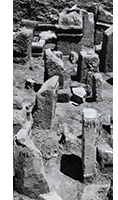|
I M A G E D A T A B A S E • D R A W I N G S & P H O T O S
|
 |
For the Kelsey excavations of 1925, the KMA holds black-and-white prints and some glass negatives from the official photographer, G. R. Swain, as well as snapshots by D. B. Harden, E. E. Peterson, and H. O'Neil. Many duplicate images and specific photographs of inscribed monuments are held by the Archives Chabot. De Prorok was an early adapter of motion picture technology and documented his excavations and expeditions, in collaboration with Pathé, but no prints have been found in their archives and are presumed lost (some clips do survive in de Prorok's 1943 documentary Ancient Trails in North Africa).
The KMA and BHL keep the correspondence of Kelsey; the Archives Chabot the correspondence of the abbé; and the GMAfr the correspondence of père A. L. Delattre. In addition to correspondence, the KMA holds excavation registries and diaries, drawings and squeezes. Many of these archival documents have been digitized as .pdf within the CT_image database.
sample: numbered stelae in situ
©2023 Archives Chabot (FE29_313 Swain 5.661)
|

 |
For the Stager excavations of 1975-79, HMANE has digitized and annotated all excavation field photographs and laboratory photographs (by R. Johnston, S. Lezon, J. Whitred, G. Wood), as well as digitizing all drawings of ceramics (by S. Brown, B. Garnand, W. R. Johnson, G. Pratico, N. Soren) and amulets (by C. Alexander, Y. Markowitz), converting rasterized drawings to vector images (by F. Gignac, sample to left). In addition, all excavation records have been scanned as .pdf documents—field diaries, locus sheets, etc. Those artifacts studied at HMANE and set to be repatriated will be 3D scanned, both for storage in the image database and to create models for display (alongside the plaster casts of Punic stelae from the earliest years of the museum).
A precise photographic recording system developed at Tell el-Hesi ( Blakely & Toombs 1980) was refined by J. Whitred and employed after the first season. For example, urns were photographed with their registry tag and a scale ruler before each lab or field photo sequence; each tag included the stratigraphic unit number, with pottery bucket and/or general registry number appended; objects and urns had additional 5x8in (.127x.203m) cards, with contact sheet or small scale prints affixed to the reverse (sample at left); and each sequence was recorded in parallel color and black & white photography.
sample: urn drawing 5882 with lid 5882A
©2023 HMANE–ASOR Punic Project (urn card 5582; vector Ai5582UC)
CT_image: OpenContext |
|
exhibition goals: Our 3D scanning initiative will archive individual scans of cippi and stelae as well as ceramics and other artifacts. Then 3D printed models would take the place of shipping and insuring artifacts. Squeezes and the 1x50m “stela roll” from the KMA will be displayed at the Badè, while both the museum and gallery would display images derived from the photographs of Swain and the snapshots of both O'Neil and Harden. Using annotated photos and site plans with scanned 3D images of stelae and urns, a model of the entire Regulus-Salammbô sector would be created from combined digital images.
|
|
|
|